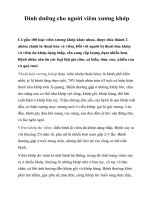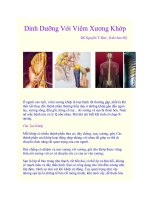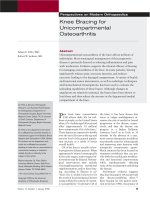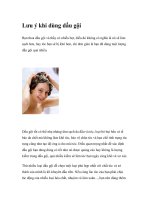Viêm xương khớp đầu gối pot
Bạn đang xem bản rút gọn của tài liệu. Xem và tải ngay bản đầy đủ của tài liệu tại đây (1.36 MB, 7 trang )
Knee Bracing for
Unicompartmental
Osteoarthritis
Abstract
Unicompartmental osteoarthritis of the knee affects millions of
individuals. Most nonsurgical management of this progressive
disease is primarily directed at reducing inflammation and pain
with medication. Evidence supports the clinical efficacy of bracing
for managing osteoarthritis of the knee. In some patients, bracing
significantly reduces pain, increases function, and reduces
excessive loading to the damaged compartment. A variety of health
and functional status instruments, as well as radiologic techniques
and biomechanical investigations, has been used to evaluate the
unloading capabilities of these braces. Although changes in
angulation are relatively minimal, the braces have been shown to
load share and thus reduce the stresses in the degenerated medial
compartment of the knee.
P
ain from knee osteoarthritis
(OA) affects daily life for mil-
lions of people; in the United States
alone, 6% of adults aged 30 years and
older (approximately 10 million)
have symptomatic OA of the knee.
1
These figures are expected to double
over the next 20 years as the age and
activity level of the general popula-
tion increase as a result of better
overall health.
OA of the knee is usually a slow-
ly progressive disease process. When
appropriately treated nonsurgically
in the early stages, major surgical in-
tervention may be delayed. Nonsur-
gical intervention may include
viscosupplementation, nutritional
supplementation, and/or knee brac-
ing. According to Sharma et al,
2
“knee OA is widely believed to be
the result of local mechanical factors
acting within the context of system-
ic susceptibility.” In primary OA of
the knee, it has been shown that
varus or valgus malalignment in-
creases the risk of medial or lateral
progression of the disease, respec-
tively, and that the disease can
progress to a higher Kellgren-
Lawrence level
3
in as little as 18
months. In the absence of a cure,
most current therapeutic modalities
are primarily aimed at reducing pain
and improving joint function with
nonspecific symptomatic agents.
Much attention has been focused on
treatment modalities that can pro-
vide both the needed pain modifica-
tion and functional improvement
while simultaneously affecting
some of the mechanisms underlying
the disease.
Preliminary evidence suggests
that knee bracing for OA can provide
that disease-modifying effect.
2,4
Knee bracing for OA gained atten-
tion in the late 1980s. Acceptance of
Fabian E. Pollo, PhD
Robert W. Jackson, MD
Dr. Pollo is Director, Orthopaedic
Research, and Assistant Administrator
for Orthopaedics, Department of
Orthopaedic Surgery, Baylor University
Medical Center, Dallas, TX. Dr. Jackson
is Chief, Emeritus, Department of
Orthopaedic Surgery, Baylor University
Medical Center.
Dr. Pollo or the department with which
he is affiliated has received research or
institutional support from Bledsoe Brace
Systems and Generation II USA. Neither
Dr. Jackson nor the department with
which he is affiliated has received
anything of value from or owns stock in a
commercial company or institution
related directly or indirectly to the
subject of this article.
Reprint requests: Dr. Pollo, Baylor
University Medical Center, Sixth Floor,
South Hoblitzelle Building, 3500 Gaston
Avenue, Dallas, TX 75246-9990.
J Am Acad Orthop Surg 2006;14:5-11
Copyright 2006 by the American
Academy of Orthopaedic Surgeons.
Perspectives on Modern Orthopaedics
Volume 14, Number 1, January 2006 5
such bracing has increased over the
past 15 years, as evidenced by the
large number of knee brace designs
on the market and their increased
use.
5
An estimated 125,000 braces
for knee OA were sold in the United
States in 2002.
5
Currently, 12 major
companies produce more than 30
commercially available off-the-shelf
and custom-made knee braces spe-
cifically indicated for knee OA.
5
Re-
tail prices for off-the-shelf braces
range from $700 to $1,000; those for
custom-made braces, from $900 to
$1,300.
5
A custom-made brace may
be necessary for the obese patient
whose leg is difficult to fit with a
standard off-the-shelf design. Sever-
al studies demonstrate the efficacy
of knee braces and their mechanisms
of function.
Clinical Studies
Braces for managing unicompart-
mental OA of the knee are designed
to reduce excessive loading on the
damaged compartment, with the de-
sired outcome of lessened pain and
increased function. In one early
study, Horlick and Loomer
6
evaluat-
ed 39 patients with medial compart-
ment OA who were treated with
a medial compartment–unloading,
valgus-producing brace. The study
involved a crossover design, with
each patient evaluated for 6 weeks
under three conditions: no brace, the
brace in neutral alignment, and the
brace in valgus alignment. Assess-
ment of pain using a visual analog
scale during activities of daily living
demonstrated a reduction in pain
only during the interval with the
brace in valgus alignment (P <
0.0001). In a subsequent retrospec-
tive study of 233 patients with medi-
al compartment OA who wore a
brace for a mean of 25.6 months, the
majority (>70%) showed overall pain
reduction in the evening, as well as
during exercise.
7
In another randomized prospec-
tive trial of patients with medial
compartment OA, each received ei-
ther standard medical treatment
(control group), a neoprene sleeve, or
a valgus-alignment knee brace.
8
Two
disease-specific, health-related, qual-
ity of life instruments—the Western
Ontario and McMaster Universities
(WOMAC) OA index and the
McMaster-Toronto Arthritis (MAC-
TAR) patient preference disability
questionnaire—and two functional
scores were used to evaluate 119 pa-
tients at baseline, 6 weeks, 3
months, and 6 months. Normal and
overweight patients with a body
mass index <35 kg/m
2
were included
in the study. At 6 months, signifi-
cant improvement was noted with
both the WOMAC (P = 0.001) and
MACTAR (P ≤ 0.001) outcome mea-
sures in both the neoprene-sleeve
and valgus-brace groups compared
with the control group. However,
the disease-specific WOMAC pain
scores demonstrated that the valgus-
brace group significantly reduced
their pain compared with both the
neoprene-sleeve group (P = 0.045)
and the control group (P < 0.001)
(Figure 1).
Draper et al
9
correlated subjective
and objective outcome measures by
using the Hospital for Special Sur-
gery knee score and instrumented
gait symmetry in their study of 30
patients treated with a valgus knee
brace for medial compartment OA.
At 3 months, patients showed signif-
icant improvement in Hospital for
Special Surgery scores (P < 0.001) and
in gait symmetry, as assessed in the
swing phase (P = 0.005) and stance
phase (P = 0.0235).
Two additional studies, both us-
ing a visual analog scale to assess
pain and the Cincinnati knee score
to assess function, demonstrated sig-
nificant improvement when patients
wore valgus braces to treat OA of the
knee.
10,11
Hewett et al
10
reported sig-
nificant improvement in pain and
function compared with baseline at
9 weeks (P = 0.0001 and P = 0.001, re-
spectively) and at 1 year (P = 0.0001
and P = 0.0008, respectively) in pa-
tients wearing a different type of
valgus-producing brace. In 11 pa-
tients with medial compartment ar-
throsis, Lindenfeld et al
11
reported a
48% decrease in pain (P = 0.01) and a
69% increase in function (P = 0.004)
with valgus bracing.
Twenty-eight patients who used a
valgus brace for medial compart-
ment OA reported improvement in
resting pain, night pain, and pain
with activity.
12
The patients had an
average body mass index of 27.2
(range, 15 to 38) and moderate to se-
vere arthritis (2 patients with Outer-
bridge grade I, 13 with grade II, and 8
with grade III arthritis).
13
Five pa-
tients were lost to follow-up.
Gait Analysis Studies
Early gait analysis studies focused
on the alterations produced by knee
braces on gait mechanics in an at-
tempt to explain the results. Initial-
ly, it was thought that the pain
reduction and functional improve-
ment in OA patients was caused by
the changing biomechanics of the
gait pattern, leading to lower forces
in the affected compartment. The
studies focused on the effects of
knee bracing for OA on gait mechan-
ics, which varied from simple tem-
porospatial measurements to full
three-dimensional gait analysis. In a
series of 119 patients undergoing
functional gait analysis at 6-month
follow-up, the valgus knee brace sig-
nificantly improved functional per-
formance during a 6-minute walk (P
= 0.021) and 30-second stair climb
(P = 0.016), compared with a neo-
prene sleeve and anti-inflammatory
drugs.
8
Other studies also reported
improvement in temporospatial pa-
rameters (eg, walking velocity, stride
length) with the valgus knee
brace.
4,8-11
Alterations in lower limb joint ki-
nematics also have been observed
with knee bracing for OA; the coro-
nal knee angle was the primary pa-
rameter that improved. This result is
not surprising in view of the realign-
ment mechanism of these braces.
Knee Bracing for Unicompartmental Osteoarthritis
6 Journal of the American Academy of Orthopaedic Surgeons
Most studies reported only a few de-
grees of var us angle reduction during
gait, mostly during the lower force
areas of the stance phase.
14,15
Even
though the angular changes were
small, it seems logical that reducing
the varus angle of the knee during
walking would reduce the loads
transmitted to the medial compart-
ment.
The external coronal moment (ie,
torque) is an important mechanism
involved with loading the knee joint
during gait. This moment is generated
when the foot contacts the ground
during stance phase and the ground
reaction vector falls either medial
(varus moment) or lateral (valgus mo-
ment) to the knee joint in the coro-
nal plane. The coronal moment,
which typically is varus, places more
load on the medial compartment than
on the lateral compartment during
gait.
16-18
This may explain why OA is
more prevalent in the medial than the
lateral compartment.
Concurrent presence of both an
increased external knee varus mo-
ment and varus malalignment in pa-
tients with OA has been reported in
several studies.
16,18
Because knee
braces for OA apply counteracting
forces to the knee (ie, a valgus mo-
ment in the presence of medial in-
volvement), the expectation would
be that the external moments are re-
duced. Bowton et al
19
first investigat-
ed this phenomenon. Using three-
dimensional gait analysis, they
studied eight OA patients with and
without a valgus-producing knee
brace. Five of the eight patients dem-
onstrated a reduction in the total
varus moment during gait with the
brace. In 1994, Pollo et al,
20
using
three-dimensional gait analysis,
studied nine patients with knee OA
and reported similar findings. Dur-
ing the highest loading portion of
stance, the valgus brace significant-
ly (P < 0.05) reduced the varus mo-
ment at the knee (Figure 2).
It was also postulated that, in ad-
dition to reducing the external varus
moment during gait, valgus braces
assisted the knee joint in absorbing
those external forces.
20
In other
words, in an unbraced condition, the
knee would need to counteract the
entire external varus moment,
which would fall predominantly on
the medial compartment. In the val-
gus braced condition, however, the
knee would receive help from the
brace, which would absorb some of
that external load.
Radiologic Studies
Several radiologic studies have been
performed to investigate the effect of
knee bracing for OA on the weight-
bearing coronal tibiofemoral angle.
In 1993, Horlick and Loomer
6
exam-
ined 39 OA patients using a pos-
teroanterior radiographic view with
the knee in 30° of flexion. No chang-
es were noted in the tibiofemoral an-
Figure 1
Western Ontario and McMaster Universities (WOMAC) OA index aggregate (A) and pain (B) scores of the three patient groups
with medial compartment arthritis that were treated with medication (control), a neoprene sleeve, or a valgus brace. The worst
score possible in panel A is 2,400 mm, and in panel B, 500 mm. (Reproduced with permission from Kirkley A, Webster-Bogaert
S, Litchfield R, et al: The effect of bracing on varus gonarthrosis. J Bone Joint Surg Am 1999;81:539-548.)
Fabian E. Pollo, PhD, and Robert W. Jackson, MD
Volume 14, Number 1, January 2006 7
gle with the addition of a valgus
brace. However, two subsequent
studies reported small changes in
the tibiofemoral angle with valgus
bracing; the largest change was ap-
proximately 4°.
14,21
This small
change could be within the range of
measurement error; taking measure-
ments from radiographic film is not
extremely precise. Also, one differ-
ence between the later studies and
the earlier Horlick and Loomer
study
6
was the positioning of the
limb during radiography. In the later
studies, the patient’s knees were in
full extension.
Komistek et al
14
used fluoroscopy
to examine the dynamic effect of a
knee brace on the coronal knee angle
and joint space separation in OA pa-
tients. In 15 patients with unicom-
partmental OA of the knee who were
wearing a valgus knee brace, the au-
thors reported an average of 1.2 mm
condylar separation on the medial
side and a tibiofemoral coronal angle
change of approximately 2.2° just af-
ter heel strike (Figure 3). In theory, a
visible condylar separation implies
that the compar tment is at least par-
tially unloaded. However, this condy-
lar separation occurred just after heel
strike, when there is typically a s mall
external valgus moment about the
knee that assists in unloading the
medial compartment.
In 1999, Katsuragawa et al
22
used
dual-energy x-ray bone densitometry
to investigate the effect of valgus
knee bracing on the bone mineral
Figure 2
Mean external varus moment about the knee in nine OA patients with and without a
valgus knee brace. The solid line represents the braced condition, and the dashed
line, the unbraced condition. The solid bars represent the areas during the gait cycle
that are significantly different.
20
Figure 3
Fluoroscopic images of an OA patient at heel strike without (A) and with (B) a knee brace. A significant increase in the joint
space in the medial compartment is visible in panel B. Insets, Frontal views of the experimental setup with the patient on the
treadmill without (inset A) and with (inset B) knee bracing. (Reproduced with permission from Komistek RD, Dennis DA,
Northcut EJ, Wood A, Parker AW, Traina SM: An in vivo analysis of the effectiveness of the osteoarthritic knee brace during heel-
strike of gait. J Arthroplasty 1999;14:738-742.)
Knee Bracing for Unicompartmental Osteoarthritis
8 Journal of the American Academy of Orthopaedic Surgeons
density of the proximal tibia in 14
patients with OA. The patients were
tested before bracing and at 3
months. The authors theorized that
if a valgus-producing brace shifted
load from the medial to the lateral
compartment, there should be some
evidence of increased bone mineral
density on the lateral side as a conse-
quence of the increased load. The au-
thors reported a 7% increase in bone
mineral density on the lateral com-
partment of the braced knee (P =
0.011) over the 3-month period; the
unbraced knee had only a 4% in-
crease (P = 0.09), thus proving that
OA bracing can alter load distribu-
tion in the knee joint.
Compartmental Load
Studies
Pollo et al
15
evaluated load sharing
and knee compartmental load re-
duction during gait in 11 patients
with isolated medial compartment
OA who were treated with valgus
bracing. The braces were instru-
mented with strain gauges, which
recorded the unloading moment (ie,
torque) placed on the leg during
walking. This information provided
the load-sharing capabilities of the
brace and enabled determination of
the net external varus moment on
the knee. Previous three-dimen-
sional gait analysis studies were ca-
pable of measuring only the total
external varus moment, which in-
cluded the portion absorbed by the
knee and the portion absorbed by
the brace. The net external knee mo-
ment was reduced by as much as
20% in the Pollo study. The authors
developed an analytical model to es-
timate medial and lateral knee com-
partment forces. Their data demon-
strated that with a valgus brace, the
load on the medial compartment
could be reduced by as much as
17%. The load reduction was depen-
dent on the amount of valgus correc-
tion adjusted into the brace (Figure
4). The results also demonstrate
that, as more correction is placed
into a valgus brace, more load shar-
ing can be accomplished. Otis et al
23
reported similar load-sharing results
with a different OA knee brace de-
sign.
In 2001, Anderson et al
24
took
load-sharing investigations one step
further by using a method to direct-
ly measure compar tment unloading.
They temporarily implanted pres-
sure sensors in the medial compart-
ment of five OA patients during pre-
scheduled arthroscopic procedures.
After sensor implantation, each pa-
tient stood while medial compart-
ment forces were directly recorded
during single- and double-leg stand-
ing trials. The patients performed
these tests unbraced and with four
commercially available OA knee
braces. The authors repor ted an aver-
age medial compar tment load reduc-
tion of 68% during double-leg stance
and 61% during single-leg stance in
braced knees, compared with un-
braced knees.
24
Clinical Indications
and Use
The primary indication for knee
bracing is pain and swelling caused
by mild to severe arthrosis in a pa-
tient who is willing to use and can
tolerate an external brace. Patients
who need to delay realignment os-
teotomy or knee replacement also
may benefit. Currently, there is no
firm guideline regarding how much
coronal angulation is too much, but
manufacturers recommend varus or
valgus angulation ≤10°. The coronal
deformity need not be passively cor-
rectable. These braces seem to work
more by sharing the load with the af-
fected compartment than by altering
the coronal angle.
The duration of brace use during
the day may vary from patient to pa-
tient. Patients with milder degrees
of arthritic change may need to wear
the brace only during high-impact
activities, such as sports, walking
long distances, or standing for long
periods. However, patients with
more advanced stages of OA may
need to wear the brace all day. With
bracing, the patient determines
when to wear the brace based on his
or her symptoms. Most current
brace designs contain features that
allow the patient to adjust the degree
of unloading.
Contraindications
Contraindications to knee bracing
include marked bicompartmental
arthritic changes in the tibiofemoral
joint and notable knee instability.
Figure 4
The average medial compartment load for a group of OA patients in four conditions:
unbraced, bracing with 4° of valgus correction, bracing with 4° of valgus correction
and a tight Dynamic Force Strap (Össur, Reykjavik, Iceland), and bracing with 8°
of valgus correction.
15
Fabian E. Pollo, PhD, and Robert W. Jackson, MD
Volume 14, Number 1, January 2006 9
Patients with medial compartment
arthritis who have injury or chronic
stretch of the medial collateral liga-
ment or other medial or anteromedi-
al structures of the knee should
avoid using a valgus-unloading
brace. Patients with lateral compart-
ment arthritis who have injury or
chronic stretch of the lateral collat-
eral ligament or other lateral or pos-
terolateral connective structures of
the knee should avoid using a varus-
unloading brace. Because these brac-
es are designed to unload the com-
partments through coronal plane
torque, patients with problems in
the medial or lateral structures of
the knee may be susceptible to fur-
ther damage of those structures with
the continued stress applied by the
braces. In addition, patients with a
flexion contracture >10° probably
should avoid this form of therapy.
Patellofemoral involvement
should not be a contraindication for
bracing, although skin or peripheral
vascular disease may prevent its use.
Obesity is not a contraindication,
but a custom-made brace may be re-
quired. Several studies have shown
that even obese patients may attain
pain relief with bracing when they
are properly fitted with a custom-
made design or a brace that incorpo-
rates a knee-ankle-foot orthosis to
increase the lever arm.
Summary
Knee bracing for OA may effectively
relieve pain and improve function in
the arthritic population. Bracing is
beneficial for many different types of
patients, regardless of age, sex, or
weight. In several studies, patients
with a body mass index >35 (ie, mor-
bidly obese) were successfully treat-
ed. Patient compliance may be a
problem with bracing because the
patients may easily remove the de-
vice. Although no published studies
have specifically investigated pa-
tient compliance with bracing, our
experience indicates that most pa-
tients (>75%) will continue to use
braces for many years when the
braces are properly fitted and the pa-
tients educated on their use. The po-
tential for side effects, such as skin
breakdown, cellulitis, and allergic
reactions, is relatively small.
Although published studies have
evaluated several brace designs, (eg,
single-hinge, double-hinge, with dy-
namic force straps, with condylar
pads), in no study have these differ-
ent braces been compared with each
other. Therefore, deciding which
brace to prescribe is based only on
the available clinical and biome-
chanical research. Biomechanical
data for a few brace designs have
confirmed that claims of unloading
are valid. Other factors, such as
proprioception and knee joint
stability, also may contribute to
brace function. Because patients
with a varus alignment have in-
creased risk for medial OA progres-
sion, it has been suggested that mo-
dalities that reduce the load on the
involved compartment may modify
the disease course. However, this
supposition is unproved. It may be
helpful to combine knee bracing
with other forms of nonsurgical
management, such as nonsteroidal
anti-inflammatory dr ugs, viscosup-
plementation, and nutritional sup-
plementation.
References
1. Felson DT, Lawrence RC, Dieppe PA,
et al: Osteoarthritis: New insights. I:
The disease and its risk factors. Ann
Intern Med 2000;133:635-646.
2. Sharma L, SongJ, Felson DT,Cahue S,
Shamiyeh E, Dunlop DD: The role of
knee alignment in disease progression
and functional decline in knee os-
teoarthritis. JAMA 2001;286:188-
195.
3. Hart DJ, Spector TD: Radiographic
criteria for epidemiologic studies of
osteoarthritis. J Rheumatol Suppl
1995;43:46-48.
4. Hillstrom HJ, Brower DJ, Bhimji S, et
al: Abstract: Assessment of conserva-
tive realignment therapies for the
treatment of varus knee osteoarthritis:
Biomechanics and joint pathophysiol-
ogy. Gait Posture 2000;11:170.
5. US Orthopaedic Braces and Support
Market, 2004. San Antonio, TX: Frost
& Sullivan, July 2004. www.frost.com.
Accessed August 22, 2005.
6. Horlick SG, Loomer RL: Valgus knee
bracing for medial gonarthrosis. Clin
J Sport Med 1993;3:251-255.
7. Horlick SG, Kwon BK, Berkowitz J,
Glick N: Functional knee bracing for
the treatment of unicompartmental
gonarthrosis. Presented at the Univer-
sity of British Columbia 1996 Ortho-
pedic Update Meeting, Vancouver,
British Columbia, June 1996.
8. Kirkley A, Webster-Bogaert S, Litch-
field R, et al: The effect of bracing on
varus gonarthrosis. J Bone Joint Surg
Am 1999;81:539-548.
9. Draper ER, Cable JM, Sanchez-
Ballester J, Hunt N, RobinsonJR, Stra-
chan RK: Improvement in functionaf-
ter valgus bracing of the knee: An
analysis of gait symmetry. J Bone
Joint Surg Br 2000;82:1001-1005.
10. Hewett TE, Noyes FR, Barber-Westin
SD, Heckmann TP: Decrease in knee
joint pain and increase in function in
patients with medial compartment
arthrosis: A prospective analysis of
valgus bracing. Orthopedics 1998;21:
131-138.
11. Lindenfeld TN, Hewett TE, Andriac-
chi TP: Jointloading with valgus brac-
ing in patients with varus gonarthro-
sis. Clin Orthop 1997;344:290-297.
12. Finger S, Paulos LE: Clinical and bio-
mechanical evaluation of the unload-
ing brace. J Knee Surg 2002;15:155-
159.
13. Outerbridge RE: Theetiology of chon-
dromalacia patellae: 1961. Clin
Orthop 2001;389:5-8.
14. Komistek RD, Dennis DA, Northcut
EJ, Wood A, Parker AW, Traina SM:
An in vivo analysis of the effec-
tiveness of the osteoarthritic knee
brace during heel-strike of gait.
J Arthroplasty 1999;14:738-742.
15. Pollo FE, Otis JC, Backus SI, Warren
RF, Wickiewicz TL: Reduction of me-
dial compartment loads with valgus
bracing of the osteoarthritic knee.
Am J Sports Med 2002;30:414-421.
16. Baliunas AJ, Hurwitz DE, Ryals AB, et
al: Increased knee joint loads during
walking are present in subjects with
knee osteoarthritis. Osteoarthritis
Cartilage 2002;10:573-579.
17. Noyes FR, Schipplein OD, Andriacchi
TP, Saddemi SR, Weise M: The ante-
rior cruciate ligament-deficient knee
with varus alignment: An analysis of
gait adaptations and dynamic joint
loadings. Am J Sports Med 1992;20:
707-716.
18. Sharma L, Hurwitz DE, Thonar EJ, et
Knee Bracing for Unicompartmental Osteoarthritis
10 Journal of the American Academy of Orthopaedic Surgeons
al: Knee adduction moment, serum
hyaluronan level, and disease severity
in medial tibiofemoral osteoarthritis.
Arthritis Rheum 1998;41:1233-1240.
19. Bowton EJ, Hoffinger SA, Larsen RV,
Augberger S: Kinetic analysis of a me-
dial hinge knee brace for medial com-
partment gonarthrosis. Journal of
Orthopedic Transactions 1994;18:
910-911.
20. Pollo FE, Otis JC, Wickiewicz TL,
Warren RF: Biomechanical analysis of
valgus bracing for the osteoarthritic
knee. Gait Posture 1994;2:63.
21. Matsuno H, Kadowaki KM, Tsuji H:
Generation II knee bracing for severe
medial compartment osteoarthritis of
the knee. Arch Phys Med Rehabil
1997;78:745-749.
22. Katsuragawa Y, Fukui N, Nakamura
K: Change of bone mineral density
with valgus knee bracing. Int Orthop
1999;23:164-167.
23. Otis JC, Backus SI, Campbell DA, et
al: Abstract: Valgus bracing for knee
osteoarthritis: A biomechanical and
clinical outcome study. Gait Posture
2000;11:116-117.
24. Anderson IA, MacDiarmid AA, Pan
DW, Phelps RC, Harris ML, Walsh
WR: Does valgus bracing relieve knee
medial compartment pressures? An
arthroscopic study. 68th Annual
Meeting Proceedings. Rosemont, IL:
American Academy of Orthopaedic
Surgeons, 2001, p 600.
Fabian E. Pollo, PhD, and Robert W. Jackson, MD
Volume 14, Number 1, January 2006 11









